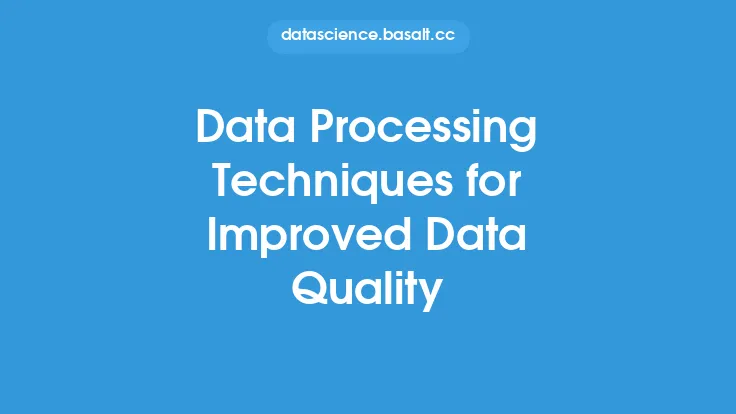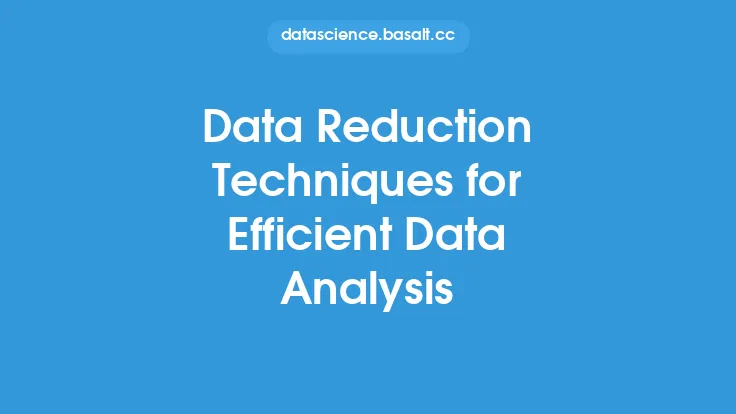Data transformation is a critical step in the data mining process, as it enables the conversion of raw data into a format that is suitable for analysis. The goal of data transformation is to improve the quality of the data, making it more accurate, complete, and consistent. In this article, we will explore various data transformation techniques that can be used to improve data quality, including data cleaning, data normalization, data aggregation, and data feature scaling.
Introduction to Data Transformation Techniques
Data transformation techniques are used to modify the format, structure, or content of data to make it more suitable for analysis. These techniques can be applied to various types of data, including numerical, categorical, and text data. The choice of technique depends on the specific requirements of the analysis and the characteristics of the data. Some common data transformation techniques include data cleaning, data normalization, data aggregation, and data feature scaling. Each of these techniques has its own strengths and weaknesses, and the choice of technique depends on the specific goals of the analysis.
Data Cleaning Techniques
Data cleaning is an essential step in the data transformation process, as it enables the removal of errors, inconsistencies, and missing values from the data. There are several data cleaning techniques that can be used, including data profiling, data validation, and data normalization. Data profiling involves analyzing the data to identify patterns, trends, and correlations, while data validation involves checking the data for errors and inconsistencies. Data normalization involves transforming the data into a standard format, such as converting all dates to a standard format. Some common data cleaning techniques include handling missing values, removing duplicates, and correcting errors.
Data Normalization Techniques
Data normalization is a technique used to transform data into a standard format, making it easier to compare and analyze. There are several data normalization techniques that can be used, including min-max normalization, z-score normalization, and logarithmic normalization. Min-max normalization involves scaling the data to a common range, usually between 0 and 1, while z-score normalization involves transforming the data to have a mean of 0 and a standard deviation of 1. Logarithmic normalization involves transforming the data using the logarithmic function, which can help to reduce the effect of extreme values.
Data Aggregation Techniques
Data aggregation involves combining multiple values into a single value, such as calculating the mean or sum of a set of values. There are several data aggregation techniques that can be used, including grouping, filtering, and sorting. Grouping involves combining values based on a common attribute, such as grouping sales data by region. Filtering involves selecting a subset of values based on a condition, such as selecting only values that meet a certain criteria. Sorting involves arranging values in a specific order, such as sorting data by date or alphabetical order.
Data Feature Scaling Techniques
Data feature scaling involves transforming the data to have similar scales, making it easier to compare and analyze. There are several data feature scaling techniques that can be used, including standardization, normalization, and logarithmic scaling. Standardization involves transforming the data to have a mean of 0 and a standard deviation of 1, while normalization involves scaling the data to a common range, usually between 0 and 1. Logarithmic scaling involves transforming the data using the logarithmic function, which can help to reduce the effect of extreme values.
Advanced Data Transformation Techniques
In addition to the basic data transformation techniques, there are several advanced techniques that can be used to improve data quality. These include data transformation using machine learning algorithms, such as decision trees and clustering, and data transformation using statistical techniques, such as regression and time series analysis. Machine learning algorithms can be used to identify patterns and relationships in the data, while statistical techniques can be used to model and forecast the data.
Best Practices for Data Transformation
To ensure that data transformation is effective, it is essential to follow best practices. These include documenting the data transformation process, testing the data transformation techniques, and validating the results. Documenting the data transformation process involves keeping a record of the techniques used, the parameters set, and the results obtained. Testing the data transformation techniques involves evaluating the effectiveness of the techniques and identifying any errors or inconsistencies. Validating the results involves checking the transformed data for accuracy and completeness.
Common Challenges in Data Transformation
Despite the importance of data transformation, there are several common challenges that can arise. These include handling missing values, dealing with data quality issues, and selecting the appropriate data transformation technique. Handling missing values involves deciding whether to impute or delete the missing values, while dealing with data quality issues involves identifying and correcting errors and inconsistencies. Selecting the appropriate data transformation technique involves considering the characteristics of the data and the goals of the analysis.
Future of Data Transformation
The future of data transformation is likely to involve the use of advanced techniques, such as machine learning and artificial intelligence, to improve data quality and enable more effective analysis. These techniques can be used to automate the data transformation process, identify patterns and relationships in the data, and predict future trends and behaviors. Additionally, the increasing use of big data and cloud computing is likely to require the development of new data transformation techniques that can handle large volumes of data and scale to meet the needs of complex analyses.
Conclusion
In conclusion, data transformation is a critical step in the data mining process, as it enables the conversion of raw data into a format that is suitable for analysis. Various data transformation techniques can be used to improve data quality, including data cleaning, data normalization, data aggregation, and data feature scaling. By following best practices and using advanced techniques, such as machine learning and statistical modeling, it is possible to improve the effectiveness of data transformation and enable more accurate and informative analysis. As the field of data mining continues to evolve, it is likely that new data transformation techniques will be developed to meet the needs of complex analyses and large volumes of data.





